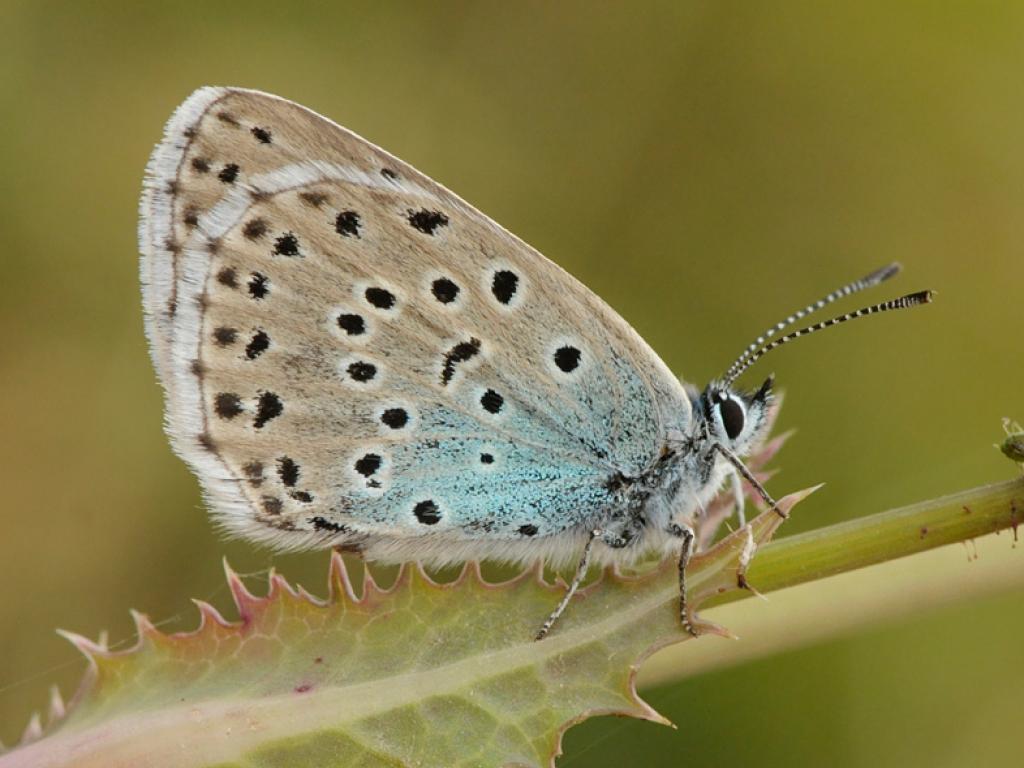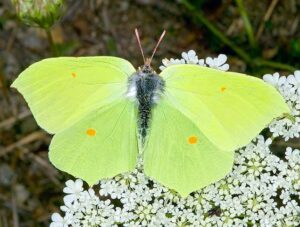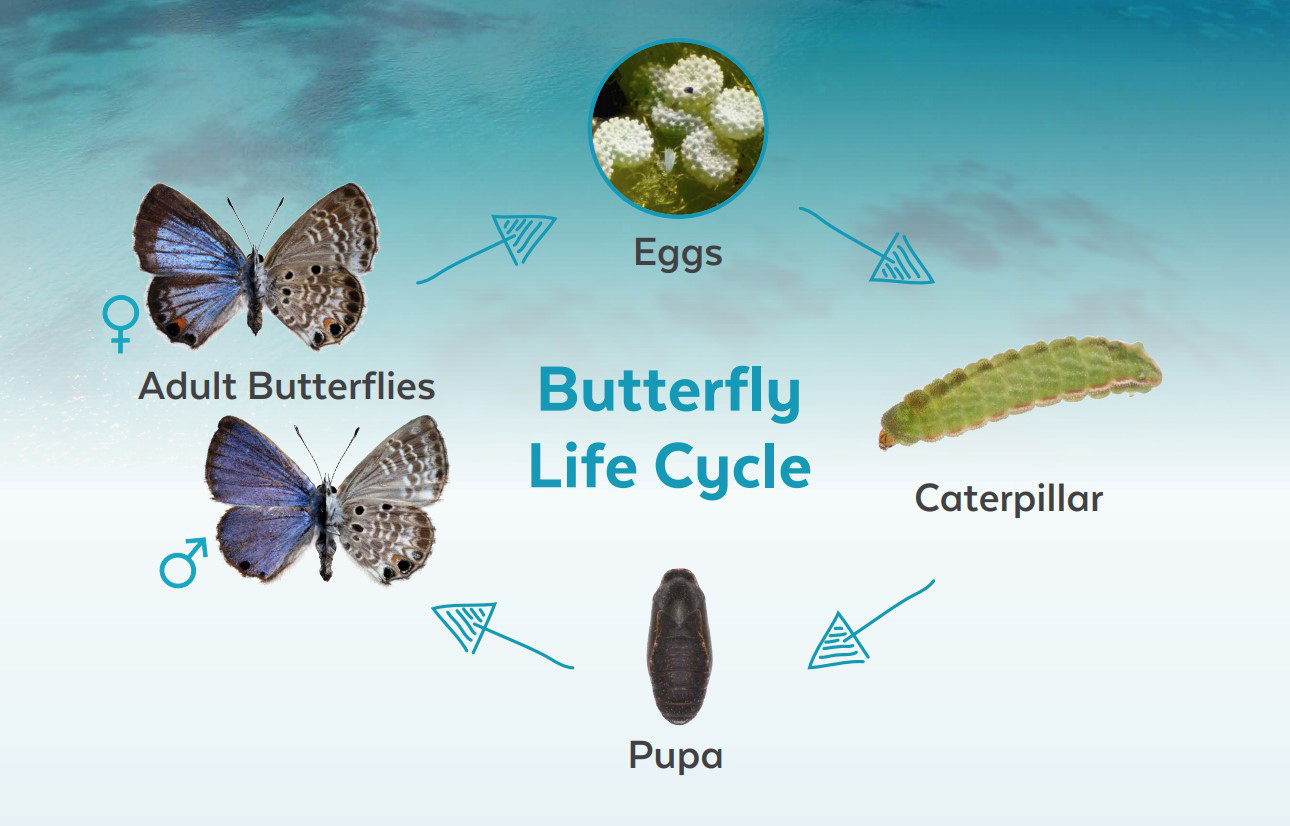
This is the largest and rarest of our blue butterflies, distinguished by the unmistakable row of black spots on its upper forewing. Undersides are pale brown with black spots. The Large Blue is one of the most enigmatic butterflies, whose remarkable life cycle involves spending most of the year within the nests of red ants, where the larvae feed on ant grubs.
The Large Blue has always been rare in Britain and became extinct in 1979, but it has been reintroduced from continental Europe as part of a long-term and highly successful conservation project.
The Large Blue is declining throughout its world range and is endangered globally.
Size and Family
- Family: Blues
- Size: Small/Medium
- Wing Span Range (male to female): 38-44mm
Conservation Status
- Section 41 species of principal importance under the NERC Act in England
- UK BAP: Priority Species
- Butterfly Conservation priority: High
- European status: Endangered
- Fully protected In Great Britain
Caterpillar Foodplant
Larvae initially feed on the flower-heads of Wild Thyme (Thymus polytrichus) but from their fourth instar they feed on ant grubs within the nests of the Myrmica red ants. Survival rates are highest within nests of Myrmica sabuleti and much poorer in those of M. scabrinodis. Eggs may be laid on Wild Marjoram (Origanum vulgare) but this usually flowers too late to be used on most British sites.
Habitat
Warm and well-drained unimproved grasslands, usually acidic coastal grassland or limestone grassland.
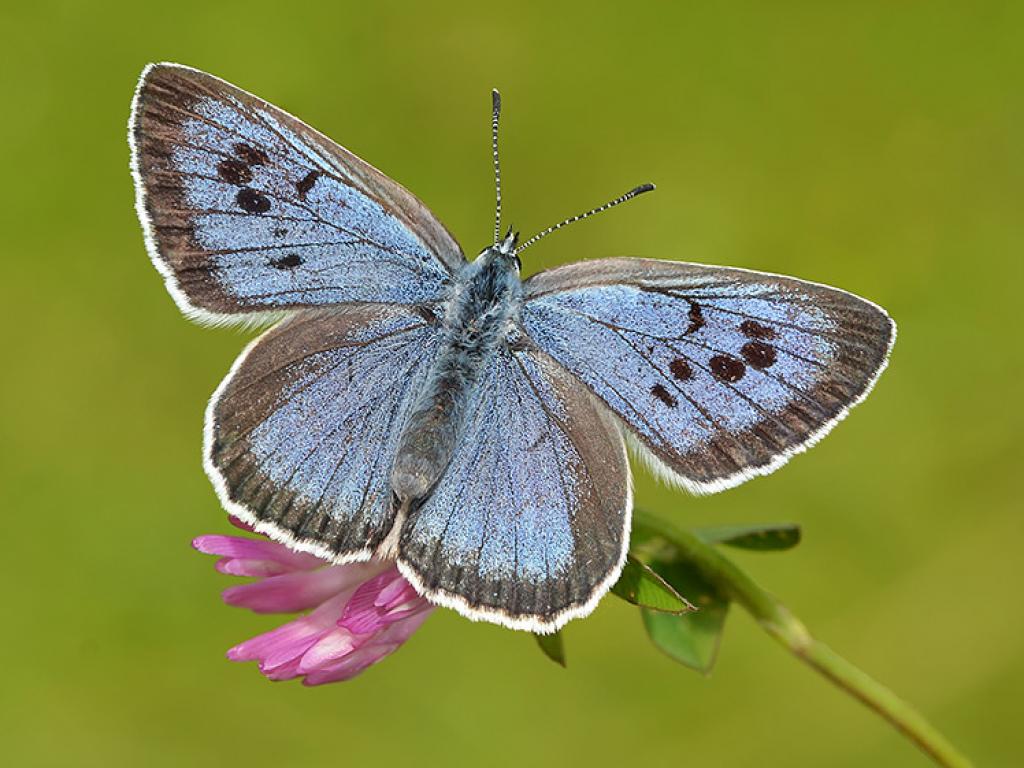
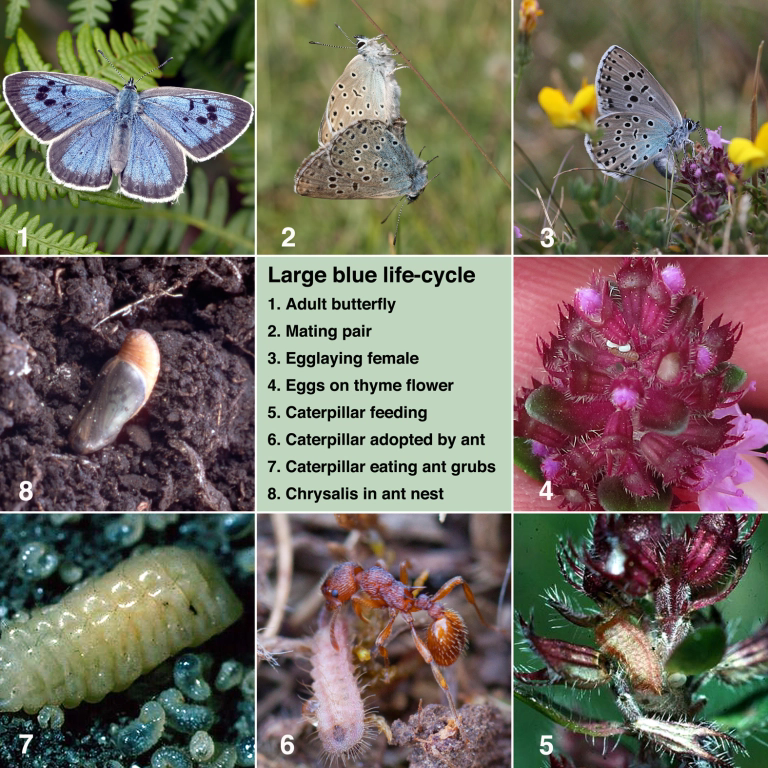
The large blue butterfly (Phengaris arion) is a rare and fascinating species with a complex life cycle and unique ecological relationships. Here’s an overview of its life cycle, habitat, diet, and interesting facts:
Life Cycle
The large blue butterfly goes through several distinct stages in its life cycle:
- Egg: Female butterflies lay eggs on specific host plants, primarily wild thyme (Thymus polytrichus) or wild marjoram (Origanum vulgare).
- Larva/Caterpillar:
- Pupa: The caterpillar either pupates inside the ant nest or crawls out to pupate elsewhere.
- Adult: The adult butterfly emerges and completes the cycle.
Habitat
The large blue butterfly inhabits specific types of grasslands:
- Warm and well-drained unimproved grasslands
- Usually found in acidic coastal grassland or limestone grassland
- Requires short grass on slopes to maintain suitable conditions for the Myrmica ant colonies
The butterfly is very rare and currently found only in southwestern England, where it has been reintroduced through conservation efforts.
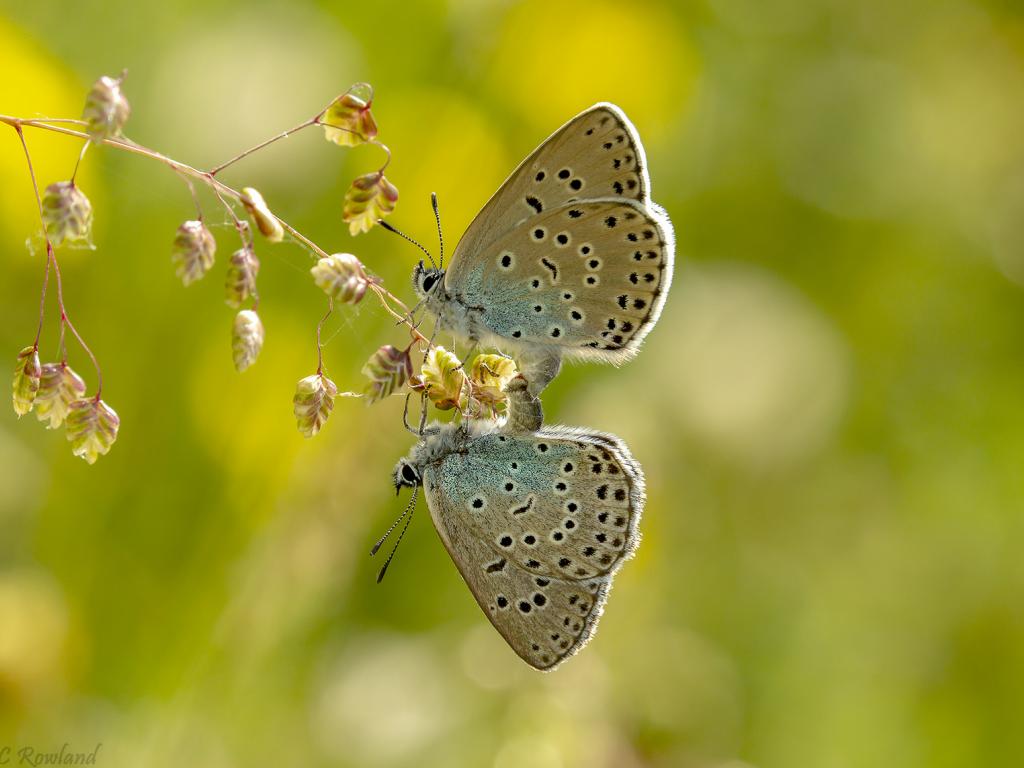
Diet
The large blue’s diet varies throughout its life cycle:
- Caterpillar (early instars): Feeds on flower heads of wild thyme or wild marjoram
- Caterpillar (later instars): Becomes carnivorous, feeding on Myrmica ant grubs within the ant nest
- Adult butterfly: Likely feeds on nectar from various flowers, though specific information was not provided in the search results
Interesting Facts
- Conservation success story: The large blue became extinct in Britain in 1979 but has been successfully reintroduced through a long-term conservation project.
- Brood parasitism: The large blue is a brood parasite, relying on Myrmica ants to raise its young.
- Chemical and acoustic mimicry: The caterpillars use chemical signals and possibly acoustic mimicry to deceive the ants and integrate into their colonies.
- Cannibalistic behavior: If two eggs hatch on the same flower, one caterpillar may eat the other.
- Global conservation status: The large blue is declining throughout its world range and is considered endangered globally.
- Size: It is the largest and rarest of the blue butterflies in Britain, with a wingspan ranging from 38-44mm.
- Legal protection: The large blue is fully protected in Great Britain and is a priority species for conservation.
- Specialized relationship: The butterfly’s survival is closely tied to the presence of specific ant species, particularly Myrmica sabuleti.
This remarkable butterfly demonstrates the intricate relationships that can exist in nature and highlights the importance of understanding these connections for successful conservation efforts.
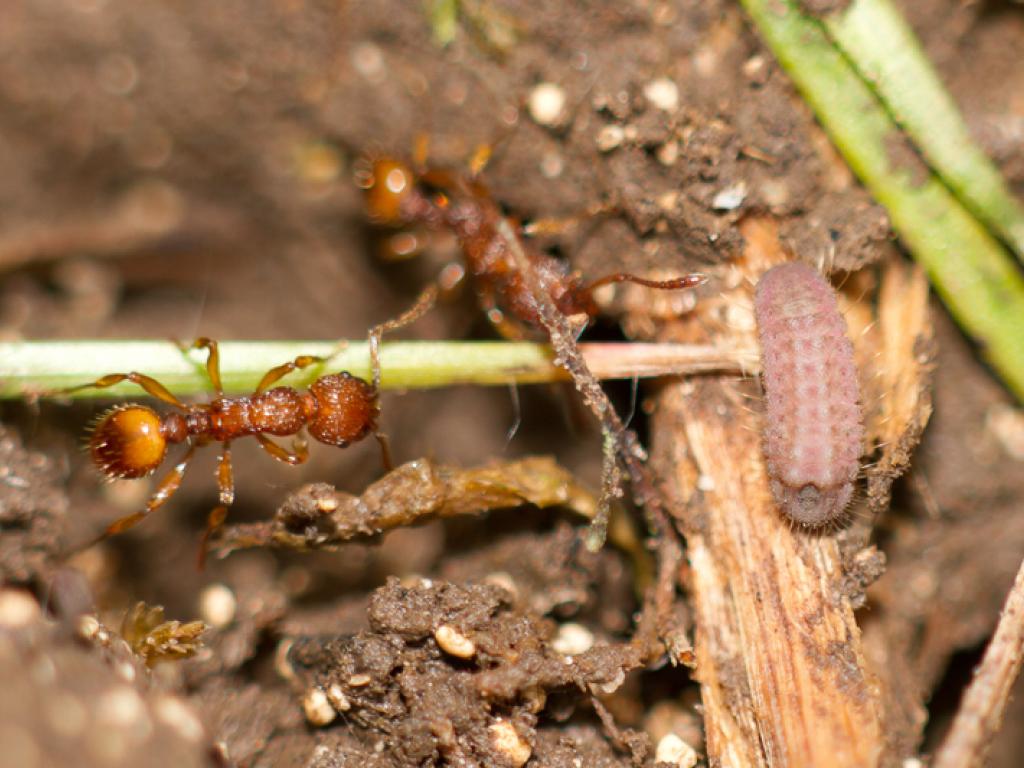
The habitat of the large blue butterfly is largely influenced by location of its food sources. The species requires a combination of abundant amounts of its larval food plant, Thymus drucei and the presence of Myrmica sabuleti ants in order to survive.
It has also been found that an underlying key factor for the survival of the large blue is site heterogeneity. The butterfly is most abundant in pastures and abandoned areas of diverse vegetation and shrubbery. This preference can be explained by examining the result of a uniform landscape. A constant landscape synchronizes many biological activities including flowering of host plants, adult emergence dates, or larval pressures on the ant colonies. If important biological functions take place at the same times, the population becomes much more susceptible to random unfortunate events such as environmental disasters.Thus traditional farming acts to desynchronize the biological system, and allows for re-colonization of patches that are temporarily untouched.The presence of differing sites and varied ecological structures provides differing microclimates that can make a huge impact on the survival of the large blue butterfly.
The Large blue female lays her eggs on a flower of wild thyme. The first instar caterpillar burrows into a floret and begins to eat all parts of the flower. When the caterpillar reaches its fourth instar it drops to the ground and waits to be found by a passing red ant (Myrmica sabuleti). The caterpillar mimics the chemistry and behaviour of an ant grub. The red ant is deceived, picks it up, takes it to its nest and places it in the brood-chamber. The once herbivorous caterpillar becomes a carnivore and begins to eat the ant brood.
The caterpillar spends the winter underground and resumes feeding in the early spring before becoming a chrysalis. The newly emerged butterfly must climb through the tunnels of the ant nest before emerging into the daylight, inflates its wings and flies off in search of a mate. The life-cycle then starts all over again!

